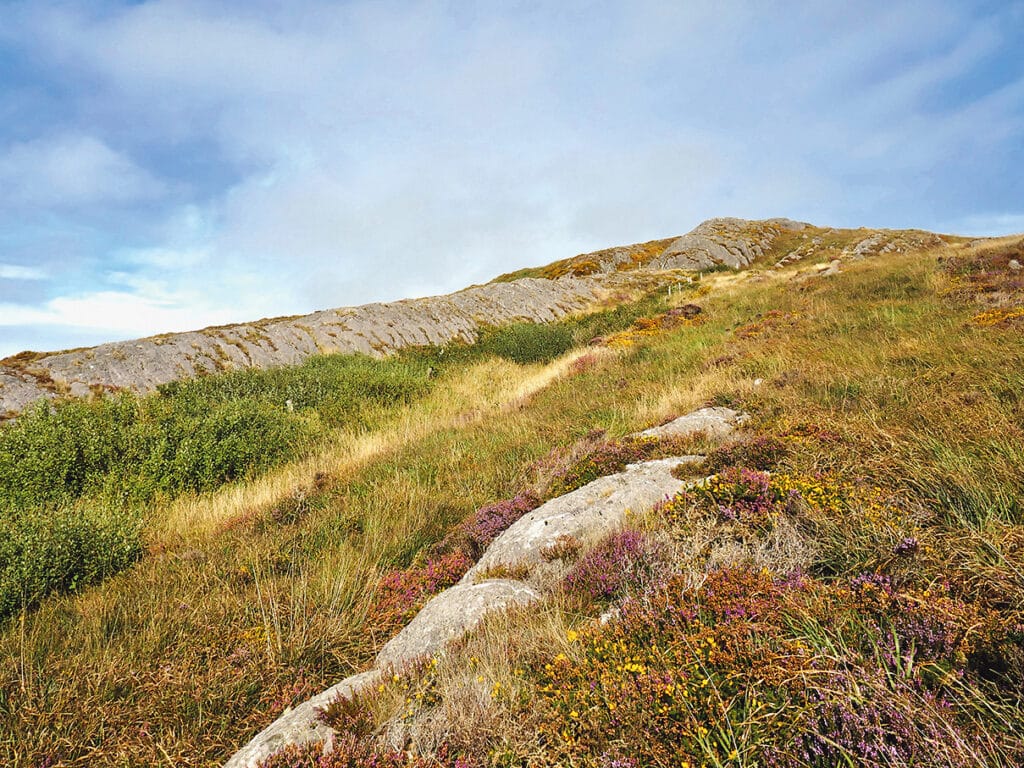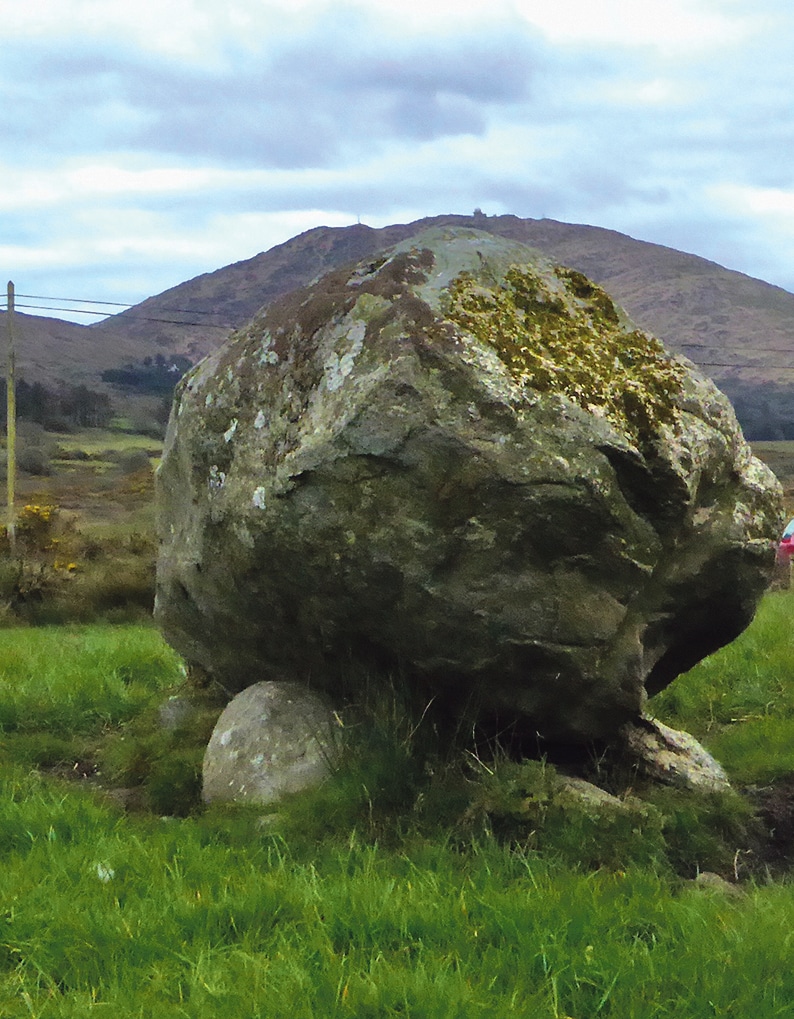
Fionn’s Ridge near Schull. Pic: Finola Finlay at roaringwaterjournal.com 
Rathruane Boulder with Mount Gabriel in background.
Pádraig Fhia Ó Mathúna (Patrick Mahony) is a researcher on the Fionn Folklore Project. He was a columnist with the West Cork People for several years.
We have probably all heard the story of Fionn mac Cumhaill’s pursuit of Diarmaid and Gráinne. It is one of the most well-known episodes in the Fionn Cycle, gracing the pages of numerous scholarly texts, children’s books and graphic novels, while also garnering countless portrayals in popular culture. Details vary, but the tale typically goes something like this: After the death of his wife, a grieving Fionn attempts to marry the High King of Ireland’s young daughter, Gráinne. On seeing Fionn at their engagement feast, Gráinne becomes deeply distressed that the aged warrior is older than her father and sets her sights on the younger and more handsome Diarmaid Ó Duibhne. After slipping a sleeping potion to the rest of the guests, she implores Diarmaid to run away with her. While he initially refuses out of loyalty to Fionn, he accepts when she threatens to put a ‘geis’ on him, making any refusal futile. The two make their way across Ireland, all the while using a host of otherworldly tactics to thwart the Fianna and the jilted lover Fionn who are hot on their trail.
At one point in their journey, Diarmaid and Gráinne seek refuge in a cave in West Cork. Diarmaid proceeds to gather a large bag of sand from Bantry Bay for he and Gráinne to sleep on. Each morning when Fionn attempts to learn of their whereabouts through the use of his ‘thumb of knowledge’, he believes that they are on a beach in Bantry Bay and scours the area. One day Diarmaid becomes complacent and lights up a cigarette. As legend has it, Fionn saw the curling wafts of smoke from ten miles away, and knew “that no man in Éire but Diarmaid could blow such whiffs of smoke as this man” given Diarmaid’s reputation as “a very hard smoker”. Fionn set off on the right path and the two lovers fled their cave, which was from then on known as ‘Leabaidh Dhiarmada’.
Ok, so this plot twist might not appear in the traditional story. But this is how locals in Gortnacowly relayed the tale to the Irish Folklore Commission in 1938. The depiction of Diarmaid as a forebearer of the Marlboro Man might have been too much, even for the collector, who added a cautionary note: “Though smoking was hardly then known, I wrote the story down as I heard it by the old people.”
The many tellings of ‘Tóraíocht Dhiarmada agus Ghráinne’, each with their own local flavour, are among approximately 3,500 stories and songs available on the new Fionn Folklore Database (fionnfolklore.org). For the past two years, I have been employed as a researcher on this groundbreaking project, which seeks to make these stories more accessible to the public. During that time, a Scottish-based colleague and I have delved into the various tellings of these tales – which were collected from the eighteenth century up to the present day – and wrote plot summaries that account for many of the regional patterns and variations. The site has much deeper roots, however. Over a ten-year period, the project director, Dr. Natasha Sumner, tirelessly gathered and categorised these important materials from various publications and archives in Ireland, Scotland, England, the Isle of Man, the US, and Canada. Prior to this intervention, the tales were uncatalogued, meaning that despite the wealth of material, this vast corpus of Fenian folklore remained nearly impossible to evaluate and contextualise. Visitors to the site will also find glossaries, character lists, an interactive digital map, and much more. The digital map is a particularly useful tool in pinpointing storytelling trends, for instance, what tales and songs were popular in the oral tradition of any one given area.
Local tellings of the stories of Fionn and the Fianna often reflect elements of the landscape, language, and unique world views of the communities from which they were collected. In some instances, like that of Mike Kelleher of Glaun, in the parish of Schull, they can also reveal fascinating insights into the storytellers’ own lives. Originally from the townland of Ardeen in Ballyvourney, Kelleher had been a schoolmate of An tAthair Peadar Ó Laoire, before he and his family relocated to Dunmanus East on the northside of the Mizen in 1855. While Ó Laoire went on to become a leading figure in the Irish literary revival, Kelleher gained local renown as a storyteller in his own right, who was especially known for his lively accounts of “Fionn and the doings of his famous dogs.” Many of the tales in his repertoire were those which he had learnt by the firesides in his native Ballyvourney. However, he was also known to tell of one of the more popular Fionn tales associated with the landscape of Glaun, the area where he married and eventually settled.
The tale is a local adaptation of a more general motif which sees the giant Fionn throw large stones, usually during battles with other giants. These stones then remain in place, thus explaining various geographic phenomena. Around Ireland and further afield, this archetypal story has been invoked time and again to describe the origins of everything from local glacial erratic rock formations to the Isle of Man and, as perhaps most famously rehashed by the Wolfe Tones, the disputed islet of Rockall. In the latter instance, the trio invoked the well-known Fionn story to bolster Ireland’s territorial claim to the rocky crag (and its potentially lucrative oil) in the North Atlantic.
In the local version, Fionn ventures to the top of Mount Gabriel, a position from which he throws several large stones. One is said to have landed in Rathruane and another in Glaun. In the first instance the rock, which was in a farmer’s field, came to be known locally as ‘The Giant’s Stone’, owing to the still noticeable imprints of Fionn’s knee and several fingers. The same features were said to be seen in the stone located in Glaun. In Kelleher’s version, Fionn (presented as a generic giant) brings two large stones to the area in anticipation of a great battle, but upon his arrival, finds it has already ended. He sets down the two stones and departs, leaving them where they can still be found today in Lissacaha.
The story also serves as the folkloric origin of several other local geographic features. As one account collected by the Folklore Commission in the 1930s notes: “There is a little lake on the top of Mount Gabriel called Poll an Oighinn. There is a saying that Fionn mac Cumhaill took a handful of rock and threw it out into the Atlantic Ocean where it is now [known] as the Fastnet Rock or Carraig Aonair – leaving the hole of Poll an Oighinn.” Moving to the west of Gabriel is ‘Fionn’s Ridge’, the name given to large indentations in the rock formation which give the appearance of a ploughed field. An account from the 1930s observed that “Fionn’s Ridge separates Glean from Gubbeen. It is a ridge of rock with seams resembling the furrows made by a plough and it is said that Fionn mac Cumhaill ploughed it with two rams and a wooden plough.” Another account of the time observed “the scrapes are still to be seen as deep as they were at first.”
These are but a few examples of the folklore associated with Fionn mac Cumhaill and the Fianna in and around West Cork. From unique tellings of Diarmaid and Gráinne to Fionn’s lasting influence on the landscape, these tales offered storytellers a creative lens through which to view the world around them, and are still central to the rich cultural tapestry of the region. The Fionn Folklore Database has now made this material more accessible than ever. It is our hope that the site will help communities reengage this tradition and pass these tales on to future generations.
If readers know of any local Fionn folklore which has not been recorded or have a tale themselves that they would like to send on, get in touch at fionnfolklore@gmail.com or on social media @Fionnfolklore.


